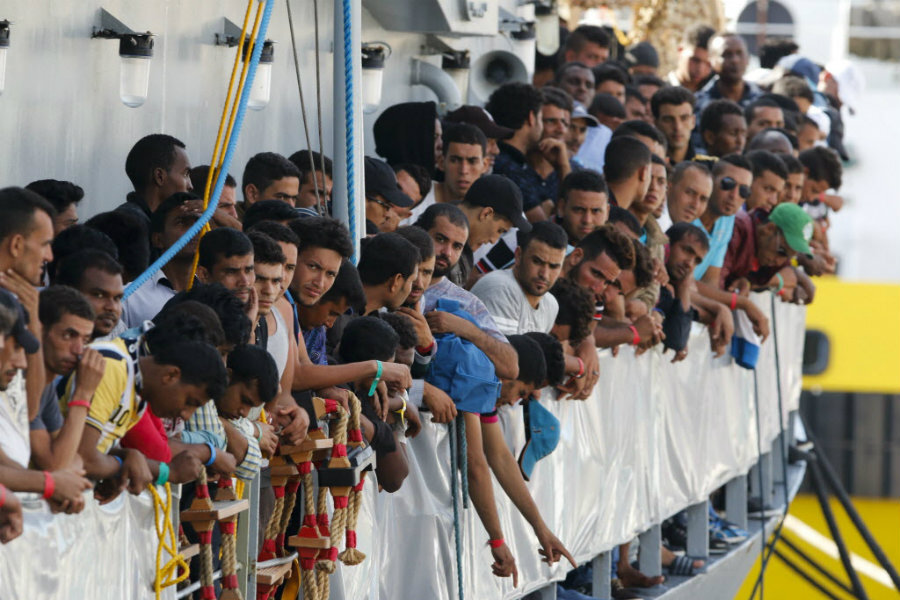By the numbers: Europe’s immigration crisis
Loading...
The refugee crisis in Europe is adding up.
Migrants from war-torn and impoverished regions in Africa and the Middle East arrive on the continent daily, straining relations among member states in the European Union, stirring nationalist sentiments, and impacting economies.
The constant influx of asylum seekers into the continent has also become a huge humanitarian consideration – one that EU leaders are under growing pressure to resolve. In the meantime, as The Christian Science Monitor wrote in June, the exodus is expected to grow.
185,000: The number of migrants who have applied for protection in the EU in the first three months of 2015. The figure represents an 86 percent increase from the same period the previous year, according to Eurostat, Europe’s statistical arm.
40: The percentage of migrants who applied for first-time asylum in Germany in the first quarter of the year, the highest of any country in the EU. The growing number has kindled anti-immigrant sentiment among Germans. But the German government welcomes immigrants as necessary to boost the country’s “graying workforce,” Chris Cottrell reported for the Monitor.
Still, Germany feels that the burden needs to be spread among the rest of Europe, to keep it manageable. “Some countries are doing very little,” German Immigration Commissioner Aydan Özoguz told The Washington Post in April. “We are one of the richest countries and we want to help, but it’s not okay that Germany, Sweden, and France are taking 50 percent of the refugees while other countries do nothing.”
144: The number of countries whose citizens have sought asylum in the EU in the first quarter of 2015, according to Eurostat. War remains the biggest single driver of migration – about 131,000 Syrians have arrived in the EU in the last 12 months, and the influx of Afghan and Ukrainian migrants persists as well, according to Eurostat.
Poverty is another factor: From January to March, nearly 50,000 people arrived from Kosovo, where the unemployment rate hovers at 35 percent.
7: The number of routes, by land and sea, that migrants take to cross into Europe, according to Frontex, the EU’s border agency. The most well-used are the Central and Eastern Mediterranean routes, through which nearly 150,000 people traveled by boat in the first half of this year. But as more migrants learn of the perils of sea crossings, a growing number have shifted to the land route through the Western Balkans into Hungary.
1,867: The number of people who have died in maritime crossing as of June 29, according to the UN High Commissioner for Refugees. Fatalities peaked in April, when a fishing vessel traveling from Libya to Italy capsized and killed 800 individuals. The incident drew attention to the booming trafficking trade in Libya, as desperate migrants paid thousands of dollars to be smuggled into Italy and Greece on rickety, unreliable vessels.
38 million: The number of euros ($41 million) that the EU has dedicated to Operation Triton, its maritime border patrol initiative, from June 2015 through the end of the year, according to Frontex, which runs the program. Triton is equipped with three airplanes, six offshore patrol vessels, 12 patrol boats, two helicopters, nine debriefing teams, and six screening teams. The amount includes a budget increase that EU leaders approved in May as a response to migrant deaths in the Mediterranean, although the program continues to face criticism for its focus on patrolling borders versus saving lives.
60,000: The number of asylum seekers that the EU in June had agreed to relocate and resettle across its member states.
It is the only remaining part of a larger plan that would have mandated all members to accept an exact number of migrants, based on factors such as population, unemployment, and economic size. But the broader plan was shelved after several countries balked, “arguing they had neither the infrastructure nor the political mandate to accept more migrants,” the Monitor’s Sara Miller Llana reported.
The EU is expected to finalize the relocation plan in July.








